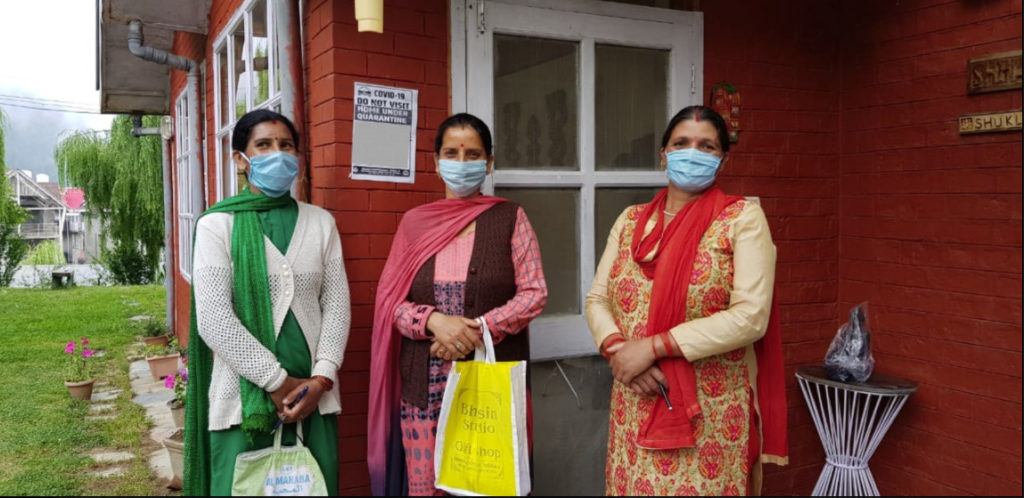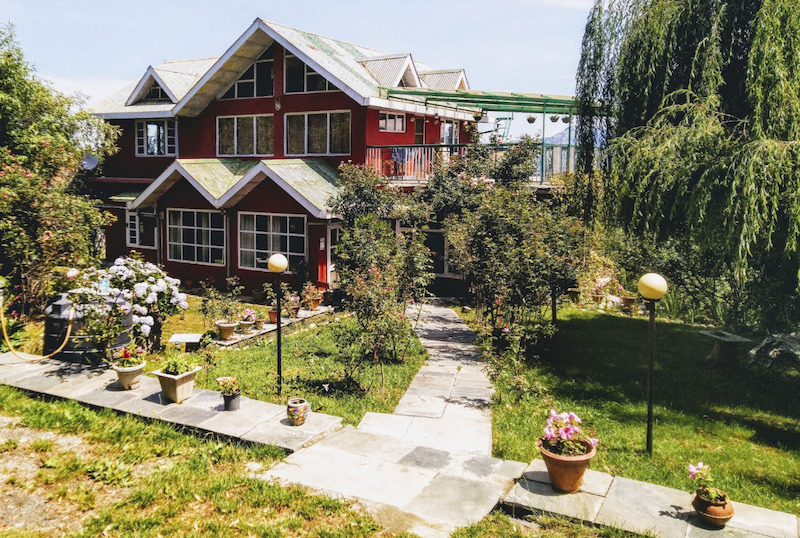My family and I normally “migrate” to our cottage in Puranikoti village near Shimla every year in April but couldn’t this year because of the lockdown and subsequent sealing of various state borders. But we finally made it in the last week of June on a domicile Himachali pass, and it’s another world here! Delhi is a toxic place, and I refer not just to the pandemic but to the whole vitiated atmosphere there- the Kejriwal- Amit Shah politics over everything, the infantile debates on TV, the perennial battle between bhakts and non believers, the claustrophobic existence of gated communities, the surreal universe of Whatsaap. We have left it all behind us now, temporarily perhaps, but for long enough to restore our mental balance and get some perspective on a life beyond the metros.
I was slightly apprehensive of the long drive from Delhi to Shimla, about 360 kms, and the three border crossings, what with each state imposing its own entry rules. In the event, however, it was uneventful: the bustle on this major highway was missing, most dhabas were closed ( my favourite, ZHILMIL at Karnal was open, however, and had even installed a sanitiser spray cubicle for guests!) The only ones making money were Mr. Gadkari’s cohorts at the toll plazas, charging exorbitant amounts for unfinished fly-overs, multiple irritating diversions and badly maintained tarmac. But the liquor vends were all open, one had even recovered its spirit enough to put up a sign with its own man ki baat: ” Sabka saath, sabka vikas; Hamari botal, aapka glass.”
Himachal is pretty well organised to receive visitors. The first barrier at Parwanoo checks your pass, the second at Shoghi ( just before Shimla) rechecks and verifies it, and also carries out a perfunctory medical check-up to ensure you won’t add to the state’s rising corona statistics. It’s hassle free, the only grievance being that it takes as much as 45 minutes to an hour, quite unnecessarily in my view; the time is taken by one having to fill in all the details of the vehicle, passengers, city of origin and destination etc in a register. Why? All the information is already in the system, as are the details of your e-pass, and it simply needs to be physically verified by identification/ address proof. Why does it have to be entered manually again in a register? I do hope the DC/SP would take note of this: it would reduce the waiting time and the long queues of vehicles drastically and make one’s arrival in Himachal a much more pleasant experience.
Notwithstanding the minor glitch above, however, the efficiency of Shimla’s district administration was on display in my village. We reached Puranikoti in the evening, and were having our breakfast on the porch the next morning, the first time in three months without an AC panting in the background, when a team of four ladies appeared out of the mist. It was the local verification squad, tasked with physically verifying all who had arrived in the panchayat from outside on a pass and reiterating the home quarantine conditions. It consisted of ASHA workers and panchayat representatives. I was truly impressed by the administration’s promptness: we had arrived here just 12 hours earlier and the surveillance system was already in top gear! The verification over, the ladies stuck a quarantine poster near our front entrance and departed without even the cup of tea Neerja offered them. Here is the proof:

They told me that the photo was needed for submission to their supervisor but I’m sure they did not want to pass up an opportunity for a photo op! To the govt’s credit, the surveillance was thorough even on subsequent days- during our two week quarantine period we have been contacted twice by the police, twice by the ASHA health worker, once each by the Health Officer and the Panchayat Pradhan. This efficiency perhaps explains why Himachal is in a relatively good place as regards the pandemic.

But at the community level there is a double edged under pinning to this surveillance if it is exercised by the locals and not by the govt. machinery, which is also happening. On the one hand it is good that rural communities are aware of the dangers posed by the virus and its potential to infect; their distrust of people from the cities is also perhaps understandable- after all, the corona has urban origins and five cities account for 80% of all cases in India. On the other hand, however, this concern and distrust can quickly degenerate into vigilantism, and we already have enough of that in India. It is also creating new divides: urban-rural, farmer-non farmer, insider-outsider, rich-have nots. These too we can do without, riven as we are with more social fault lines than we can handle.
Unsavoury incidents have already taken place in Himachal. In Kaza, the capital town of Lahaul-Spiti district, a Minister who was coming from Shimla was not allowed to enter the town and was forced to go back. There was no restriction on inter district movement within the state but the seven panchayats of the tribal district had enforced its own diktat that required all outside visitors to undergo a two week quarantine. Similarly in Kinnaur, another tribal district, a Deputy Secretary to the state govt. who was a Kinnaura himself was not allowed to go to his home in a village because he was coming from Shimla (on retirement). It required police intervention to ensure that the poor chap could enter his own house! The actions of villagers on both occasions were contrary to the govt’s policies.
My own village of Puranikoti, otherwise quiet and law abiding, has also not been exempted from the effects of this sub-virus. A couple of months ago , when the lock down was in effect, a senior retired IAS officer along with family and a few friends ventured out on a drive/ trek to a nearby temple. He was accosted by the villagers, the panchayat and police were summoned and a case registered against all of them for violating the lock down restrictions. More recently a prominent Punjab politician who has a property in the village, arrived here on a pass with a large retinue of security and domestic staff. Some of the latter were allegedly not covered by the pass and the locals once again protested vehemently; they had to return. These incidents show a heightened awareness in the rural communities, which in itself is not a bad thing. Those coming from outside, or even those lately settled in these communities, should be sensitive to their concerns, scrupulously adhere to the govt’s rules and keep the local administration informed of their arrival/ movements. But as the Kinnaur and Kaza episodes show the local zeal can quickly get out of hand. I decided to be careful and transparent about my visit and had whatsapped a copy of my pass beforehand to the panchayat Pradhan to belay any concerns she may have had. There were no problems subsequently.
But Covid has sown the seeds of mistrust of “outsiders” for the future. This is bound to be exacerbated in the days to come in two ways. One, I suspect tourists will face a lot of hostility when tourism finally opens up. Second, post the pandemic more and more city dwellers will be looking to acquire a second home in states like Himachal as a retreat for the inevitable subsequent pandemics. This may be met by resistance from rural communities who already feel that these birds of passage have no stakes in these places and simply gobble up scarce land without contributing in any way to the local economy. It is a fair criticism, for most of us do not integrate into these rural communities and are content to behave like vacationers. This has to change for trust and acceptance to happen. Just as the world is headed for deglobalisation, our states may also be on the path to insularity and a different form of quarantine. Remember, it was the betrayal of trust which destroyed Eden.
[ Post script: today is the 12th day of our 14 day quarantine period. On the 10th day I was asked to take an RT-PCR test, which I did. Not since my IAS exams in 1975 have I waited so anxiously for the results! Today I was informed that my result was negative- Pappu pass ho gaya! In these topsy turvy times being negative is a positive. ]
| The author retired from the IAS in December 2010. A keen environmentalist and trekker he has published a book on high altitude trekking in the Himachal Himalayas: THE TRAILS LESS TRAVELLED.
His second book- SPECTRE OF CHOOR DHAR is a collection of short stories based in Himachal and was published in July 2019. His third book was released in August 2020: POLYTICKS, DEMOCKRAZY AND MUMBO JUMBO is a compilation of satirical and humorous articles on the state of our nation. His fourth book was published on 6th July 2021. Titled INDIA: THE WASTED YEARS , the book is a chronicle of missed opportunities in the last nine years. Shukla’s fifth book – THE DEPUTY COMMISSIONER’S DOG AND OTHER COLLEAGUES- was released on 12th September 2023. It portrays the lighter side of life in the IAS and in Himachal. He writes for various publications and websites on the environment, governance and social issues. He divides his time between Delhi and his cottage in a small village above Shimla. He blogs at http://avayshukla.blogspot.in/ |



